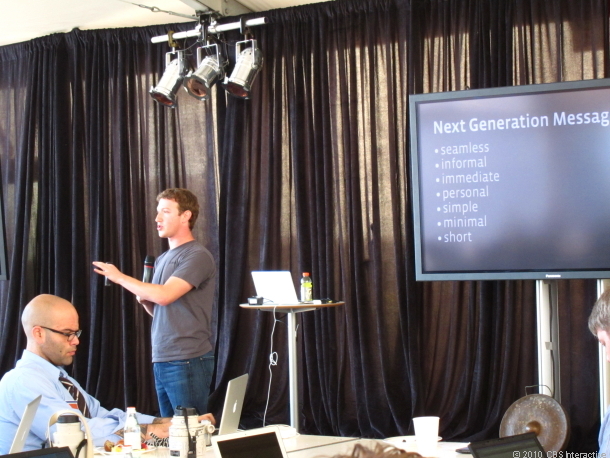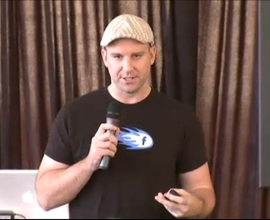
Facebook CEO Mark Zuckerberg announces the company's new "seamless messaging" product this morning at a San Francisco hotel.
SAN FRANCISCO–“We don’t think that a modern messaging system is going to be e-mail,” Facebook CEO Mark Zuckerberg said in a press conference this morning as it unveiled a hotly anticipated revamp of its messaging system that many pundits had characterized as a “Gmail killer.”
But unveiling an e-mail product wouldn’t take into account all the other means of digital communication that have sprung up and are now used by hundreds of millions of people around the world, the young executive insisted. He says he was inspired by conversations with high schoolers who insisted to him that they use text messaging and Facebook messages in lieu of e-mail because “it’s too slow” and “too formal.”
So Facebook has debuted a sweeping messaging system–in the works for 15 months, according to Zuckerberg–that pulls in multiple channels of communication from across Facebook as well as other platforms, allowing for faster, shorter, and more real-time forms of messaging as well as Facebook’s existing messaging service and chat client. Facebook messaging and chat are used by 350 million of Facebook’s 500 million-plus active users around the world, and with 4 billion messages sent per day.

Andrew Bosworth, the engineer who spearheaded Facebook's new messaging system, speaks at today's product unveiling.
“It’s not e-mail. It handles e-mail in addition to Facebook messages, and Facebook IM, and other IM and SMS and all the other different ways that you want to communicate,” Zuckerberg said. “It’s true, people are going to be able to have Facebook.com e-mail addresses, but it’s not e-mail.”
The product offers “seamless messaging” across different forms of communication–Facebook messages, e-mails, instant messages from a variety of clients, and text messages–aggregated conversation histories between any two given Facebook users, and a “social in-box” to prioritize messages that matter. This last feature is much like the Gmail “priority in-box” that Google has been testing out over the past few months.
“People should share however they want to share,” said Andrew Bosworth, the Facebook engineer who spearheaded the project. “If you want to send me an e-mail and I want to get it on Facebook, that’ll work. If you want to chat with me and I want to get it on Facebook Messages, that’ll work too.” There is, at this point, no voice chat, but Zuckerberg said that option may come into play depending on demand for it.
The “social in-box” will weigh priority of messages based on conversation histories and which contacts are likely to get ongoing responses, filtering out spam as well. Facebook members will also have the option of only receiving messages at their Facebook.com addresses, which are based on the Facebook user names that were first introduced earlier this year.
The Facebook messaging overhaul caps off a season of perpetual product releases and revamps from Facebook, from Facebook Places in August to the Groups overhaul this fall. But this one will be slower to percolate into the Facebook user base: invitation-only for now, it will be rolling out over the next few months.
While Facebook claims this isn’t meant to kill e-mail clients, it’s clear that e-mail providers are noticing. AOL, for one, pushed out a preview of its e-mail overhaul this weekend. Google, meanwhile, has been making one attempt after another to use Gmail and Gchat users’ networks of contacts as the basis for next-generation messaging products, but it hasn’t had much luck: Google Buzz was poorly received, and the more experimental Google Wave was shut down altogether after a few months.

